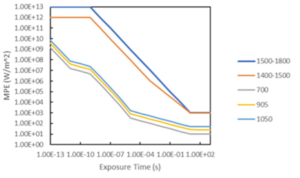By Thomas Merelle
Light Detection and Ranging (LiDAR) is a method for determining variable distance. Using a laser to target objects, it measures the time taken for reflected light to return to the receiver. It can also measure velocity using the same principle as radars in microwave frequencies.
Eye-safe laser scanning (or 3D scanning) can be used to generate digital representations of physical environments, such as models of the Earth’s surface and ocean floor. These qualities mean LiDAR has applications across a broad range of industries, from agriculture through to spaceflight.
With applications ranging from robotics and drones to high-resolution mapping and geology, LiDAR supports mobile, terrestrial, and airborne applications, including autonomous driving vehicles.
A LiDAR is made out of 3 main components which work together:
The basic operating principle of how LiDAR works is simple:
LiDAR sensors are the eyes of autonomous driving vehicles – but they don’t actually do the driving themselves! LiDAR allows autonomous vehicles to ‘see’ their environment by measuring and generating millions of data points, which create a real-time map of the surroundings. Due to a lower average speed in urban driving environments, autonomous vehicles need LiDAR sensors to range up to 200 metres (with reflectivity as low as 10 percent which is roughly the same reflectivity as a car tyre).
When driving at higher speeds on a highway, freeway, or motorway, it becomes more difficult to detect small objects, debris, or anything else in the road. Whilst a 200-metre range is good for many purposes, the ability to see beyond 300 meters with greater precision is the ideal for front-facing LiDAR applications to improve the performance and safety of autonomous vehicles.
When a vehicle with Advanced Driver Assistance System (ADAS) is used on a highway, freeway, or motorway, where it must change lanes, mid to short range LiDARs on the side of the vehicle are also required. They need less output power, but optics are adapted to provide relevant resolution at a range of a few meters.
Watch this short video to find out more about how LiDAR works in autonomous driving vehicles:
In general, autonomous driving vehicles have a camera, radar, and 1 to 3 LiDARs (varying from a car to a truck). Remember the three main components of LiDAR (light transmitter, receiver, and computing unit)? Photonics Integrated Circuits (PICs) contain photons (light particles) and deliver the light source required. But how do they work?
Indium phosphide photonic chips have the capability of delivering low linewidth, tunable lasers. These lasers increase resolution and range, resulting in better object detection over longer distances and increased image resolution when driving at high speeds. Line widths in the order of 100 kHz are the optimum, as larger line widths will result in poor spatial resolution.
This type of photonic chip provides higher power output, which means it sends out more photons, creating a more accurate data map of the surroundings to enhance safety. Another benefit is that sunlight fluxes are also lower at these wavelengths (ranging between 1280nm and 1650nm). This means that LiDAR range can be increased without any safety or parasitic sunlight concerns.
To avoid endangering bystanders, eye-safety is crucial. In order to meet standards in eye-safety, LiDAR manufacturers follow strict safety guidelines. Lasers have been widely and safely used for a long time in a range of applications, from home security systems to light shows.
Indium phosphide photonic chips support the infra-red operating range, common to optical telecommunications (ranging between 1280nm and 1650nm). This wavelength is not able to reach the retina so your eyes are kept safe at all times.

Eye safety LiDAR
In order to build a LiDAR sensor, one imaging technology and one ranging technology must be combined.
The components of LiDARs all have Photonic Integrated Circuits inside: the computing unit has a silicon chip (only in case of TOF), and the light transmitter/receiver has indium phosphide chips. For the light source, multiple elements are important, such as low-linewidth tunable lasers and high output power stand out.
For autonomous driving, (FMCW) LiDAR is very likely to become its navigator. Of all available LiDAR sensors, this seems the most promising one for autonomous driving. This is mostly due to its high reactivity rate, high resolution, and speed of data.
Today, technology is everywhere around us and part of our everyday lives. Technology like integrated photonics plays an essential role in finding and developing solutions for the world’s problems, such as reducing energy consumption, improving healthcare, fighting food waste and satisfying our continuous hunger for information. SMART Photonics offers solutions for data and telecommunication, as well as for sensing – such as Lidar – and medical applications. And it doesn’t stop there.
SMART Photonics aims to improve people’s lives and create a better world with the help of integrated photonics. We are an independent pure-play foundry – producing high-end Photonic Integrated Circuits for customers. One that thinks along. Our goal? To always look for innovative solutions that make a difference for our customers. From proof of concept to full production. Adding value at every step of the way. And no matter what the challenge is, we make it happen.
Learn more about our multi-project wafer service (MPW).
How can you engage with our organisation and bring your bright idea to life? Check the opportunities of our Multi-Project Wafer!
MPWSMART Photonics is rapidly growing. Join us with the photonics revolution and apply now!
Careers
Do you have a question or would you like to make an appointment? Send me a message!